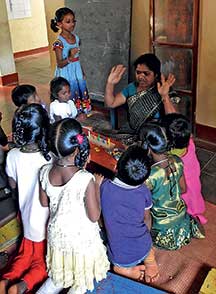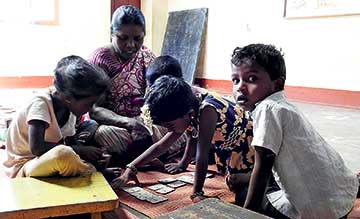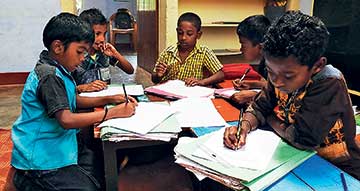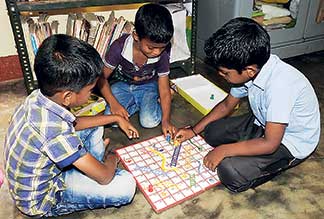B. Ramdas and Rama Sastry
Every classroom, every school, whether we like to admit it or not, reflects, in effect, a microcosm of the society we will have. Teachers and school administrators always forget this. Our schools have become such disjointed arms of society that school administrators feel that their roles are different from what the child has to do when she steps out of school. They assume that the child can make the leap, as it were. Well, the child does make the leap, but carries with it the baggage of her school days. That the child must pass through a seamless continuum from childhood to adult life is thwarted by the institution of schooling.
 I look back on my school days and realize that I have long forgotten the quadratic equations drilled into me, the parsing of clauses, whether Alexander the Great died in 248 BC or whether there are copper mines in Chile. What I do remember are the teachers who went out of their way to help us when the chips were down, teachers who kept their faith in us as responsible people, times when we came together to undertake a common task and accomplish it, when the whole school would rally together to cheer a game. These have been lasting lessons for life. I also remember every instance when I or others were unfairly reprimanded or punished or excluded with no forum to express our feelings. No child forgets these and it is these then that are moulded into the clay of the future.
I look back on my school days and realize that I have long forgotten the quadratic equations drilled into me, the parsing of clauses, whether Alexander the Great died in 248 BC or whether there are copper mines in Chile. What I do remember are the teachers who went out of their way to help us when the chips were down, teachers who kept their faith in us as responsible people, times when we came together to undertake a common task and accomplish it, when the whole school would rally together to cheer a game. These have been lasting lessons for life. I also remember every instance when I or others were unfairly reprimanded or punished or excluded with no forum to express our feelings. No child forgets these and it is these then that are moulded into the clay of the future.
To ask: So what does the classroom, and the school, have to do with creating a culture that reflects the values we would like to live by – is to ask – what is the purpose of education and the purpose of the school. We are asking what values do we want children to imbibe and carry into adulthood, what is the culture that they will live by, what traditions should they follow or not follow? But is this what our schools are working towards, or have they been reduced to teaching factories? Have not commercial interests crept in and made the process of schooling into a business? Aren’t business management courses more sought after than history or literature or the fine arts? What kind of children do these schools turn out? What would their aspirations be?
Truly, we are at crossroads today. Since we shed our submissive, colonial mantle, our feudal past, some 70 years ago, we were told to move forward to build a new world. A world where we did not fear anyone, where the old hierarchical systems were now broken and all were equal; one in which we respect each other’s differences, no matter what. The new world called for a scientific and rational temper and outlook that would help us to grasp the modern world, and, above all to conduct our lives democratically. These values have been enshrined in our Constitution and all our schools were asked to promote these. But India has an ancient tradition and as Rabindranath Tagore said we should have our feet firmly set in our tradition but our eyes and ears open to the winds of change and modernity. We can choose what we want but not shut out these winds by closing our doors and windows. Unlike many other nations our tradition has also been to draw into it a multi-cultural tapestry. We have never shied away from this. This has been and is our common tradition.
Our experience
 The classroom is where the culture of a society is played out. Our experience has taught us that the values that we want to bring into society have to form part of the school too, in fact, they must necessarily be the core of the culture of the whole school. It cannot be something applicable only to children or only for some aspects of the school life and not others. In effect, it must be the life of the school and therefore visible in every aspect of it.
The classroom is where the culture of a society is played out. Our experience has taught us that the values that we want to bring into society have to form part of the school too, in fact, they must necessarily be the core of the culture of the whole school. It cannot be something applicable only to children or only for some aspects of the school life and not others. In effect, it must be the life of the school and therefore visible in every aspect of it.
Cooperation as against competition, non-violence as against aggression, integrity as against cheating, respect for others as against contempt, democratic functioning as against blind obedience to diktats, all must be applicable to all levels, management, teachers, non-teaching staff and students. This is what is meant by ‘culture’. To practice aesthetics only in the art class but have a shoddy school campus or classroom does not make sense. We cannot tell children to do or believe in something that we ourselves do not believe in or are not practising. They can see right through us and their respect for us immediately drops. Over time they learn that they too can say one thing and do something completely different and often in contradiction. This is when the rot sets in and a counter-culture begins.
The adivasi classroom
In the initial years, the government’s Asst. Education Officer would enter the classroom and ask – which is class 1 and 2 and 3 and so on? The children would answer which group they were in. This of course infuriates them. But for the adivasi child, the need to have no physical barriers between the groups was very important. They had to see each other and if necessary get up and walk over to talk to someone else. Strangely, they could do this unobtrusively without disrupting the class. It took us some time to understand this behaviour but we realized that the feeling of being in one community is very important to them. Physical barriers actually divide them over time.
 The sense of community extended not just to each other in the school but also to the parents and members of their communities. Often parents and elders were encouraged to be part of the school and teach songs, stories, history and other cultural practices. This gave the children the feeling that the school was not separate from their home and to the elders that the school was a place they could be a part of, whenever they chose. Given the fact that they spoke a different language, had different customs and rituals from the rest of the local communities here, these people have always felt that they are apart, and have been marginalized. Now the school has found ways to restore their dignity and give them the feeling that they have an equally important place in society. In the eyes of the child this is an important message as it would otherwise lead to a sense of inferiority.
The sense of community extended not just to each other in the school but also to the parents and members of their communities. Often parents and elders were encouraged to be part of the school and teach songs, stories, history and other cultural practices. This gave the children the feeling that the school was not separate from their home and to the elders that the school was a place they could be a part of, whenever they chose. Given the fact that they spoke a different language, had different customs and rituals from the rest of the local communities here, these people have always felt that they are apart, and have been marginalized. Now the school has found ways to restore their dignity and give them the feeling that they have an equally important place in society. In the eyes of the child this is an important message as it would otherwise lead to a sense of inferiority.
What the school has tried to do is not to bring in a new culture but to enhance the culture of the adivasi community. Cooperation is a natural instinct of the children. In other schools, from the kindergarten stage children are taught not to help others, that their marks alone matter and so on. We have a completely different system where the children help and support each other and so the teacher also plays that role.
A further extension of this is that they take care of each other. For whatever reasons, we do not have disciplinary problems in the school. The older children take care of the young and of each other. There is no effort in this process. When children quarrel, some older child comes in and settles it. At times teachers interfere but only to help children see what they have done without reprimanding them.
Integrity also appears to be an essential quality. We do not have cases of cheating or stealing. Nothing in the school is locked away. We have never had to talk about honesty.
Our assembly sessions in the morning are crucial and all teachers and students attend these. This is where we talk about whatever needs to be done in the school and how we have to relate to each other. We are willing to sacrifice any class for these sessions. Children have the right to express their feelings, talk about their work, their work-duties in the school, the subjects, the craft and games they participate in. They can also talk about their problems at home. It is also a time for celebration of ourselves and so often we also have singing and dancing.
We celebrate festivals of all religions so that children are familiar with the main aspects of them. We are very conscious that we live in a pluralistic world and although the adivasi communities themselves have over time been excluded, it is important that they know and appreciate other communities and other communities respect them too. It is through these we expose children to tradition and how some important aspects of living are passed on through such practices. Tradition also helps in building dignity and a sense of identity in people. Children are taught at an early age to respect and appreciate the diversity that they see around them.
 Above all, what allows the school and its teachers to function in the way they do, which includes bringing in the ethos of the adivasi culture, is the freedom they have to make the kind of decisions they want. Managing the funds, deciding on the aspects of the syllabus, the kind of programmes to have with children are all decisions of teachers. The teachers meeting is the final decision-making authority on all matters and recommendations from here are passed on to the management committee. This attitude, this culture of freedom and responsibility gets passed on to the rest of the school too. Teachers in turn allow children to take decisions about various programmes that they have to undertake, the duties that have to be carried out, and sometimes even whether they would like to attend class or go for a walk. Teachers do not see themselves as a separate entity and many of them share the lives of the children.
Above all, what allows the school and its teachers to function in the way they do, which includes bringing in the ethos of the adivasi culture, is the freedom they have to make the kind of decisions they want. Managing the funds, deciding on the aspects of the syllabus, the kind of programmes to have with children are all decisions of teachers. The teachers meeting is the final decision-making authority on all matters and recommendations from here are passed on to the management committee. This attitude, this culture of freedom and responsibility gets passed on to the rest of the school too. Teachers in turn allow children to take decisions about various programmes that they have to undertake, the duties that have to be carried out, and sometimes even whether they would like to attend class or go for a walk. Teachers do not see themselves as a separate entity and many of them share the lives of the children.
Finally, whatever else the school may teach, if one of the main purposes is to teach children to live in the world, then it must also teach them how to build relationships. Competition has driven a wedge into these relationships. As they grow, they have to live in families, in communities, in a nation and in a diverse world. In all these, we have to relate to others, whether with those of the other sex, or other communities, other religions, other creeds. In our school we never miss the opportunity to bring people from diverse languages, cultures and nations to help understand and build bonds. There have been instances when young children have wanted to touch another person to feel what it is to have another coloured skin.
A school is essentially a cultural space. One kind of culture or the other is being transmitted there. If we are not conscious of what we want to get across, then the easiest and sometimes, basest of it all gets carried across. It is important that we remember that it is not a culture-neutral space.
The authors are founders of Vidyodaya School, Gudalur, Nilgiris, a school for adivasi children. They can be reached at bramrama@gmail.com.
